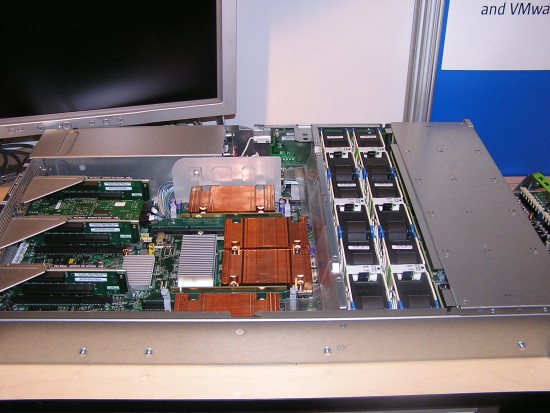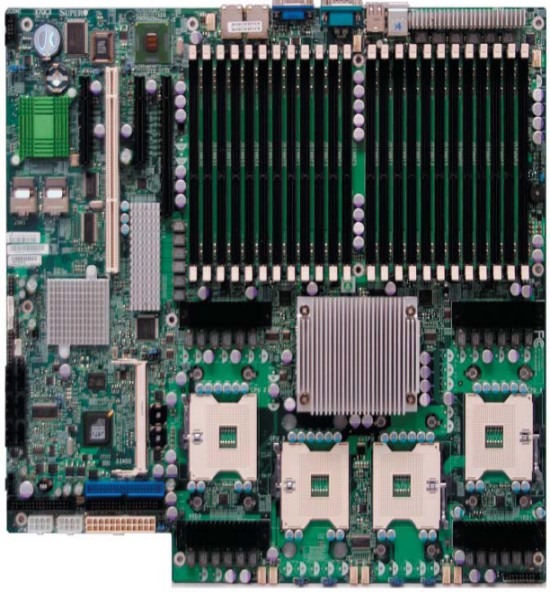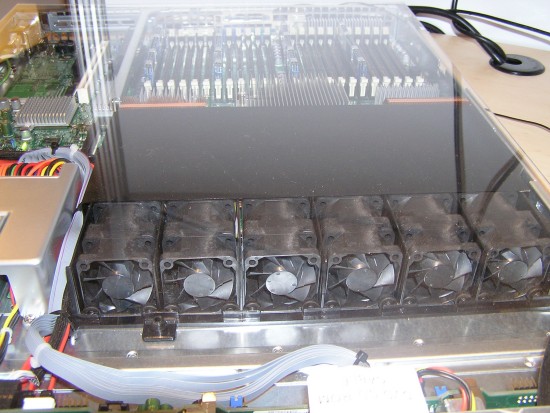Intel IDF 2007: Datacenter Technology
by Johan De Gelas on September 20, 2007 6:00 PM EST- Posted in
- Trade Shows
Dense Xeon MP Servers
Intel put the spotlight on Jim Fowler, executive vice president of Sun, as he showed off a mystery 2U server which contained four Xeon Tigerton 7300 CPUs. As always, Sun has produced a very slick and well finished design, and we took a look closer.

This new Sun server places a full "rack" of no less than 32 DIMMs on top of the Xeon MPs.

Here you can see what the server looks like once you have installed the DIMMs.

For those of you who think that four Xeon MPs in a 2U server is not dense enough, Supermicro developed the X7QC3 board. This board with support for Xeon MP 73xx and 24 DIMMs fits in a 1U server.

That is quite amazing as even the 130W 2.93GHz Xeon MPs can find a home in this server (Update: the 1U server support up to 80W per CPU, 2U and more support 130W CPUs). Remember that the Xeon MP 71xx CPUs are commonly found in 4U and 6U servers.
Other Random Tidbits
As many have previously speculated, Nehalem will have a smaller cache than Penryn, as its integrated memory controller reduces the need for a huge cache. A smaller cache means a smaller die, and this can result in higher clock speeds.
Solid state drives can deliver from 10 to 50 times more I/O operations per second than the traditional hard drives. It is only a matter of time before we will see much higher TPC-c scores with an excellent performance per dollar ratio. Gone will be the days that you need 70 to 100 disks per core to run TPC. While that is good news for the TPC-c benchmark people, it might also be excellent news for all those who are running intensively used databases... provided those databases don't require too much actual capacity.
Intel put the spotlight on Jim Fowler, executive vice president of Sun, as he showed off a mystery 2U server which contained four Xeon Tigerton 7300 CPUs. As always, Sun has produced a very slick and well finished design, and we took a look closer.

This new Sun server places a full "rack" of no less than 32 DIMMs on top of the Xeon MPs.

Here you can see what the server looks like once you have installed the DIMMs.

For those of you who think that four Xeon MPs in a 2U server is not dense enough, Supermicro developed the X7QC3 board. This board with support for Xeon MP 73xx and 24 DIMMs fits in a 1U server.

That is quite amazing as even the 130W 2.93GHz Xeon MPs can find a home in this server (Update: the 1U server support up to 80W per CPU, 2U and more support 130W CPUs). Remember that the Xeon MP 71xx CPUs are commonly found in 4U and 6U servers.
Other Random Tidbits
As many have previously speculated, Nehalem will have a smaller cache than Penryn, as its integrated memory controller reduces the need for a huge cache. A smaller cache means a smaller die, and this can result in higher clock speeds.
Solid state drives can deliver from 10 to 50 times more I/O operations per second than the traditional hard drives. It is only a matter of time before we will see much higher TPC-c scores with an excellent performance per dollar ratio. Gone will be the days that you need 70 to 100 disks per core to run TPC. While that is good news for the TPC-c benchmark people, it might also be excellent news for all those who are running intensively used databases... provided those databases don't require too much actual capacity.










12 Comments
View All Comments
afan - Friday, September 21, 2007 - link
you remarked:The supermicro site:
http://www.supermicro.com/products/motherboard/Xeo...">http://www.supermicro.com/products/motherboard/Xeo...http://www.supermicro.com/products/motherboard/Xeo...
Indicates that, yes, the board will take 130W 2.93GHz Xeons, but their 1U server chassis won't take it, alas. (If you look at their 1U server chassis, (listed as the CSE-818TQ-1000) it indicates the max for 1U is 80W CPUs. The chassis seems to support AMD chips, in fact -- confusing!).
I'm still waiting for PCI-e 2.0, More PCI-e x8 slots (2 is a joke), and dual 10gbps:
http://www.intel.com/network/connectivity/resource...">http://www.intel.com/network/connectivi...s/techno...
I wish they'd hurry up with these!
afan - Saturday, September 22, 2007 - link
I found the 1U chassis:http://supermicro.com/products/system/1U/8015/SYS-...">http://supermicro.com/products/system/1U/8015/SYS-...
I read the manual, and it confirms that it won't take 130 Watt CPUs.
Also, the spec sheet says it only has 1 PCIe x8 slot - but the manual says it can take two. WTF!?
SuperMicro website TOTALLY SUCKS. (I like their products, though).
----
What I'm really looking forward to are the boards alluded to here - of course I can't find any info on them(!):
http://supermicro.com/newsroom/pressreleases/2007/...">http://supermicro.com/newsroom/pressreleases/2007/...
Seaburg-based:
X7DWN+, X7DWA-N, X7DWT/INF and X7DWU.
San Clemente-based:
X7DCL-3/i, X7DCA-3/i and X7DCU
Bigby chipset-based:
X7SB4, X7SBE, X7SBi, X7SBL-LN1/LN2, X7SBA and X7SBU
JohanAnandtech - Saturday, September 22, 2007 - link
It would indeed make sense that the 1U is limited to 80W CPUs. I specifically asked the Supermicro people what kind of CPU the 1U could take and they told me 130W. I guess the Supermicro people were a bit too enthousiastic. I'll ask again.brshoemak - Friday, September 21, 2007 - link
Anyone else notice that the last picture on the first page shows a tabletop fan supposedly as one of the components in the server (next to hard drive)?? Must be a 5U chassis.If that was an Intel created image you would imagine they have a few resources available to them to find a picture of a case fan.
JohanAnandtech - Saturday, September 22, 2007 - link
Lol. This was indeed an Intel slide. I guess a tabletop fan is easier on the eye than a case fan? (I have no idea :-)TA152H - Friday, September 21, 2007 - link
Johan,You should probably explain what an AMB is before just introducing it. I think people will get from the context it is part of a FB-DIMM, but it probably could use some description.
Intel's marketing has permeated reports of the Nehalem. When AMD alone was working on the integrated memory controller, their caches were small because of it. Not because it wasn't needed. Now, for Intel, their caches are getting smaller because they don't need it. So, the IMC is purely wonderful, it has no side effects, right? Wrong! They can't put the same cache on the chip and sell it economically because of the IMC. It's a tradeoff.
Also, since when is a smaller chip faster? The Pentium Pro was bigger than the Pentium, but it ran at higher clock speeds. Ditto for Athlon versus K6, and Pentium 4 versus Pentium III. I think you meant that if you have a smaller cache, all other things being equal, you can run it at faster speeds(i.e. lower latency). There is one example, the Prescott, where the size of the processor (because of the power/heat) did limit the clock speed, but that was an isolated case (and one that Intel obviously never predicted when they created that monster).
JohanAnandtech - Saturday, September 22, 2007 - link
Sorry for the late answer, I was flying over the Ocean yesterday :-).I agree with the IMC assesment. It is a matter of keeping the die a bit smaller, to save costs and to get probably one extra speedbin out of it. Huge die do result into slightly slower chips though. The bigger the CPU, the bigger the chance that one of the cores can not be clocked as high as the other ones, especially at the outside of the wafer.
TA152H - Saturday, September 22, 2007 - link
Johan,I don't think that's the relevant point here, but I agree with it. Yes, more dies will result in lower clock speeds, in general, because you can only clock as high as the slowest one. No disagreement there. And more dies do make chips bigger. But, that's not what was relevant within the context of the statement. It was about a bigger cache making a processor bigger, not an additional die.
In fact, in general, bigger processors have led to higher clock speeds, not lower. The Pentium 4 and Athlon were perfect examples. A lot of transistors were put there so they could clock higher, not lower. One of the design goals of the Pentium Pro was higher clock speed too, on the same process technology, and transistors were dedicated for the stages so it could.
But, to put it another way, do you really believe that the Nehalem having a smaller cache would lead to higher clock speeds? It might have lower L2 latency, but that's not the same. Will the Penryn clock lower because it's got a bigger L2 cache? There just isn't any correlation between cache size and the clock speed a processor can run at, unless it's limited by heat, like the Prescott.
uutorok - Thursday, September 20, 2007 - link
Dare to feel your heart pound, your pulse race, and your breath catch in your throat? To open yourself up for a jolt of sheer adrenaline that just might eat you alive? To bring home a beast that’s leaping and snarling on the end of its leash?Like Mother Nature, AMD has a dark side — and on September 25, 2007
it will be revealed to the world.
So what it really comes down to is, do you dare?
http://amd-member.com/campaigns/black/
iceburger - Thursday, September 20, 2007 - link
:) almost viral marketing